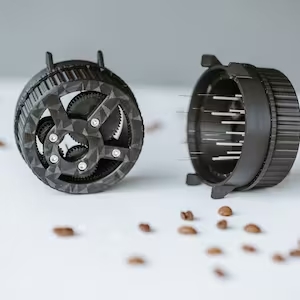What is a WDT Tool: An Essential Guide
Have you ever wondered how baristas achieve that perfect extraction and flavor in their espresso shots? Is there a secret tool they use to ensure every grain of coffee is evenly distributed?
Introducing the WDT tool, also known as the Weiss Distribution Technique tool. This small espresso accessory has been embraced by coffee enthusiasts and professionals alike, but what exactly is a WDT tool and what is it used for? Let’s explore the mechanics of this essential tool and discover how it can elevate your espresso brewing routine.
Key Takeaways:
- A WDT tool is a small espresso accessory used to evenly distribute coffee grounds in an espresso basket.
- It was popularized by coffee enthusiast John Weiss and is believed to improve coffee extraction and workflow efficiency.
- The goal of using a WDT tool is to break up clumps in the coffee grounds and create a more uniform layer for extraction.
- Proper technique and tool selection are important when using a WDT tool to prevent channeling and achieve consistent results.
- A WDT tool can be a valuable addition to a home barista’s collection, offering improved extraction and the ability to create consistent, clump-free coffee grounds.
Introducing the WDT Tool in the World of Espresso
The WDT technique, short for Weiss Distribution Technique, first emerged as a coffee forum trend before making its way into the mainstream coffee community. It was introduced by John Weiss, a passionate coffee enthusiast, on the Home-Barista coffee forum in 2005. This technique quickly gained popularity among baristas worldwide, thanks to its ability to enhance coffee extraction.
The primary objective of the WDT technique is to achieve even distribution of coffee grounds in the portafilter basket. By breaking up clumps and creating a uniform layer, the WDT technique ensures consistent water flow during extraction, resulting in a more balanced and flavorful espresso shot.
Initially, the WDT technique was performed using a single needle, but it has evolved over time to include various designs and tools. Many prominent baristas and coffee professionals have embraced the WDT technique, making it a standard puck preparation method for home baristas seeking high-quality shots.
Advancements in WDT tool technology have led to the production of various designs and materials, including 3D-printed options. These tools offer convenience and efficiency in implementing the technique. For example, the Duomo the 8 WDT tool features spinning elements that further enhance its functionality and ease of use.
Overall, the WDT technique and accompanying tools have become invaluable in the world of espresso, revolutionizing the extraction process and elevating the quality of espresso shots. Coffee enthusiasts of all levels can benefit from incorporating the WDT technique into their brewing routine for consistent and outstanding results.
The Mechanics of the Weiss Distribution Technique
The Weiss Distribution Technique (WDT) involves the use of a specialized WDT tool to ensure even distribution of coffee grounds in the portafilter basket before tamping. By breaking up clumps and spreading the coffee grounds in a more uniform layer, the WDT technique sets the foundation for optimal extraction.
To begin the WDT process, start at the edge of the portafilter and move in a circular motion around the basket, using the WDT tool. This motion helps to evenly distribute the coffee grounds throughout the entire puck. It is important to ensure that the depth of the tool reaches close to the bottom of the basket, ensuring consistent distribution.
The end result of the WDT technique should be a slightly fluffy and even layer of coffee grounds. After using the WDT tool, gently knock the portafilter on the counter to settle and pack the grounds vertically. Following this step, proceed with tamping and brewing the espresso shot in your usual manner.
The WDT technique helps to prevent channeling during extraction, ensuring that water flows evenly through the coffee grounds. This promotes consistent extraction and ultimately leads to improved coffee quality. By using the WDT tool and following the proper technique, baristas can achieve a well-distributed puck and enhance the overall extraction process.
By understanding the mechanics of the WDT technique and implementing it correctly, coffee enthusiasts can achieve consistent coffee distribution and elevate their espresso brewing routine to new heights.
Why Clump-Free Coffee Grounds Matter
When it comes to making a perfect cup of espresso, the texture and consistency of the coffee grounds play a crucial role. Clumps in coffee grounds can have a significant impact on the extraction process, leading to inconsistent flavors and less-than-ideal brews. That’s why achieving clump-free coffee grounds is important, and it’s where the WDT tool comes into play.
The Benefits of a WDT Tool
A WDT tool, such as the Weiss Distribution Technique tool, is designed to break up clumps in coffee grounds and create a more even layer. This tool helps ensure consistent extraction and flavor in your espresso shots. By using a WDT tool, baristas can achieve the following benefits:
- Better Water Flow: Clump-free coffee grounds allow water to flow more evenly during extraction, resulting in optimum flavor extraction from the coffee.
- Reduced Channeling: Proper distribution of coffee grounds reduces the chances of channeling, where water finds an easy path through the grounds, leading to uneven extraction. This contributes to a more balanced and consistent flavor profile.
- Even Expansion: Clump-free coffee grounds promote even expansion of the puck during the brewing process. This even expansion contributes to a more uniform extraction, resulting in a well-balanced espresso shot.
- Control over Extraction: Using a WDT tool gives baristas better control over the extraction process, allowing them to achieve consistent and repeatable results. This results in improved espresso quality and a more satisfying coffee experience.
The benefits of clump-free coffee grounds are evident in the taste and quality of the final espresso. With a WDT tool at hand, baristas can ensure their coffee grounds are properly distributed and ready for optimal extraction.
How to Properly Use a WDT Tool
To ensure effective usage of a WDT (Weiss Distribution Technique) tool, follow these step-by-step guidelines for consistent coffee distribution:
- Select a WDT tool with a proper design. Opt for a thin needle or a 3D-printed tool with multiple pointy objects for optimal distribution of coffee grounds.
- Place a funnel or a cut-out cup bottom on top of the portafilter to minimize mess and spills.
- Begin the distribution process by starting at the edge of the portafilter and moving in a circular motion around the basket.
- Ensure that the depth of the tool reaches close to the bottom of the basket, distributing the coffee grounds evenly throughout the entire puck.
- Finish the distribution in the middle by making small circular motions, resulting in a slightly fluffy and even layer of coffee grounds.
- Give the portafilter a gentle downward knock on the counter to settle and pack the grounds vertically.
- Proceed with tamping and brewing the espresso shot according to your usual brewing routine.
Following these steps will help you achieve consistent coffee distribution, leading to an improved overall extraction process and a more delightful coffee experience.
When to Implement the WDT in Your Brewing Routine
While the WDT technique has gained popularity, its implementation may not be necessary for all espresso setups. Factors such as the type of grinder used and the desired espresso quality should be considered when deciding to implement the WDT technique.
If you are using a clump-free grinder or a grinder that produces fluffy grounds, you may not need to use a WDT tool. Domestic espresso grinders like the Baratza Sette and Eureka Mignon Specialita are known for producing clump-free grounds, making the use of a WDT tool optional.
However, if you are grinding finer than usual or experiencing clumps with your grinder, implementing a WDT tool can be beneficial. The WDT technique helps break up clumps and ensures even distribution of coffee grounds in the portafilter basket, leading to improved extraction and a more consistent brew.
The decision to implement the WDT technique in your brewing routine ultimately depends on your specific setup and your desired level of control over the espresso extraction process. Professional baristas in a commercial environment may find the WDT technique too time-consuming and unnecessary, while home baristas seeking high-quality and consistent shots may find it valuable.
By considering the factors mentioned above and experimenting with the WDT technique, you can determine whether it enhances your espresso preparation and contributes to an elevated coffee experience.
Conclusion
The WDT tool, or Weiss Distribution Technique tool, is a valuable accessory for espresso enthusiasts seeking improved coffee extraction and workflow efficiency. Originally introduced by John Weiss, this technique aims to achieve even distribution of coffee grounds in the portafilter basket, resulting in consistent extraction and enhanced flavor.
Using a WDT tool breaks up clumps in the coffee grounds, improving water flow during extraction and reducing the chances of channeling. The proper technique and tool selection are crucial for achieving consistent and clump-free coffee grounds. While not necessary for all espresso setups, those using clump-prone grinders or grinding finer than usual can benefit from implementing the WDT technique.
Overall, the WDT tool offers home baristas the ability to achieve professional-level extraction and create high-quality espresso shots consistently. By understanding the mechanics of the WDT technique, the importance of clump-free coffee grounds, and how to properly use a WDT tool, coffee enthusiasts can enhance their espresso brewing routine and elevate their overall coffee experience.
FAQ
What is a WDT tool?
A WDT tool, or Weiss Distribution Technique tool, is a small espresso accessory used to evenly distribute coffee grounds in an espresso basket.
Who popularized the WDT technique?
The WDT technique was popularized by coffee enthusiast John Weiss, who introduced the technique on the Home-Barista coffee forum in 2005.
What is the goal of using a WDT tool?
The goal of using a WDT tool is to break up clumps in the coffee grounds and create a more uniform layer for extraction, improving coffee extraction and workflow efficiency.
What does a WDT tool do?
A WDT tool breaks up clumps in the coffee grounds, spreads them evenly in the portafilter basket, and promotes consistent extraction during brewing.
What is the history of the WDT technique?
The WDT technique was introduced by John Weiss in 2005 on the Home-Barista coffee forum. It has gained popularity among baristas worldwide and is now a standard puck preparation method for many home baristas.
Why is it important to have clump-free coffee grounds?
Clumps in coffee grounds can lead to inconsistent extraction during brewing, resulting in under-extraction or over-extraction. Using a WDT tool helps break up clumps and create a more even layer of coffee grounds, ensuring consistent extraction and flavor.
How do I properly use a WDT tool?
To use a WDT tool effectively, start at the edge of the portafilter and move in a circular motion around the basket. Ensure the depth of the tool reaches close to the bottom of the basket for even distribution. Finish with a gentle downward knock to settle the grounds before tamping and brewing.
When should I implement the WDT technique in my brewing routine?
Implementing the WDT technique depends on personal preference, the grinder used, desired espresso quality, and the need for consistent extraction. It is beneficial for those using clump-prone grinders or grinding finer than usual.
What are the benefits of using a WDT tool?
Using a WDT tool allows for consistent coffee distribution, improved extraction, and the ability to create clump-free coffee grounds. It provides better water flow during extraction, reduces the chances of channeling, and promotes even expansion of the puck for a balanced extraction.
What is the conclusion on the benefits of the WDT tool?
The WDT tool is a valuable accessory for espresso enthusiasts seeking improved coffee extraction and workflow efficiency. It helps achieve consistent, clump-free coffee grounds, resulting in high-quality, balanced espresso shots.

